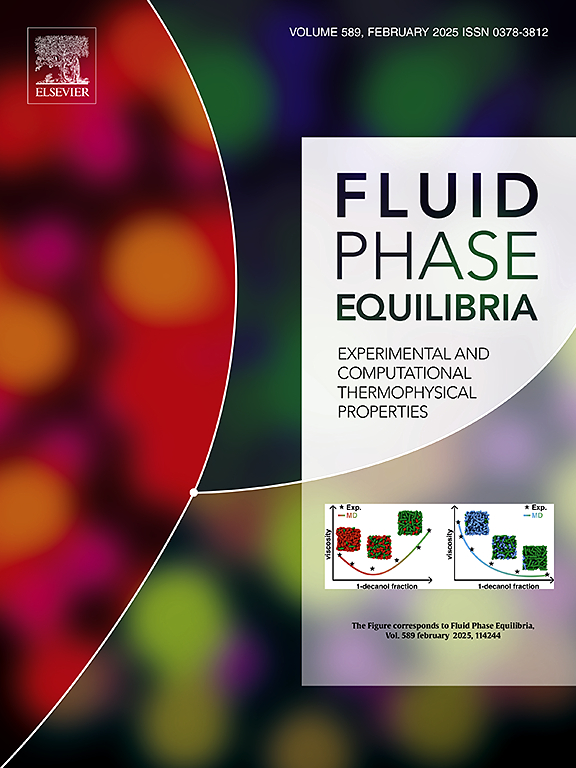Extending residual entropy scaling approach to evaluate the effect of CO2 concentration on the viscosity of aqueous NaCl solutions
IF 2.8
3区 工程技术
Q3 CHEMISTRY, PHYSICAL
引用次数: 0
Abstract
CO2 injection alternated with smart water and carbonated water injection are enhanced oil recovery (EOR) methods with a positive environmental effect, as they can trap part of the CO2 injected into the reservoir. The gas dissolved in the injected brine affects the waterfront, mobility ratio, and stability of the injected fluid coming into contact with unswept oil, increasing oil recovery. In this context, this work aimed to calculate the effect of increased CO2 concentration on the viscosity of CO2+brine mixtures. The Residual Entropy Scaling (RES) approach defines viscosity regarding thermodynamic properties, which can be derived from an Equation of State (EoS). In this study, RES model was coupled with the electrolyte Cubic Plus Association (eCPA) and Peng-Robinson-Stryjek-Vera (PRSV) EoS to describe the viscosity of aqueous NaCl solutions. A constant volume correction is also used to improve the density calculation. First, using experimental results from the literature, the adjustable parameters of eCPA and PRSV EoS were tuned to better correlate vapor-liquid equilibrium and density data for systems of interest. Then, the adjusted equations were coupled to the RES model and used to correlate the viscosity of CO2, H2O and brine. Both approaches qualitatively reproduced the effect of pressure and temperature on CO2, H2O and brine viscosity. However, when applied to CO2+water and CO2+brine mixtures, both models failed to predict the increase in viscosity as the CO2 concentration in the systems increases. Thus, a modification to the RES model's entropic term was proposed by introducing a combination rule with an adjustable binary parameter for the CO2-water pair. The modified models represented the effect of CO2 addition on the viscosity of the CO2+water system and predicted this effect on the CO2+brine system. However, the deviations between the experimental and calculated viscosity data were smaller when the eCPA EoS was used as a reference model in RES approach.

求助全文
约1分钟内获得全文
求助全文
来源期刊

Fluid Phase Equilibria
工程技术-工程:化工
CiteScore
5.30
自引率
15.40%
发文量
223
审稿时长
53 days
期刊介绍:
Fluid Phase Equilibria publishes high-quality papers dealing with experimental, theoretical, and applied research related to equilibrium and transport properties of fluids, solids, and interfaces. Subjects of interest include physical/phase and chemical equilibria; equilibrium and nonequilibrium thermophysical properties; fundamental thermodynamic relations; and stability. The systems central to the journal include pure substances and mixtures of organic and inorganic materials, including polymers, biochemicals, and surfactants with sufficient characterization of composition and purity for the results to be reproduced. Alloys are of interest only when thermodynamic studies are included, purely material studies will not be considered. In all cases, authors are expected to provide physical or chemical interpretations of the results.
Experimental research can include measurements under all conditions of temperature, pressure, and composition, including critical and supercritical. Measurements are to be associated with systems and conditions of fundamental or applied interest, and may not be only a collection of routine data, such as physical property or solubility measurements at limited pressures and temperatures close to ambient, or surfactant studies focussed strictly on micellisation or micelle structure. Papers reporting common data must be accompanied by new physical insights and/or contemporary or new theory or techniques.
 求助内容:
求助内容: 应助结果提醒方式:
应助结果提醒方式:


